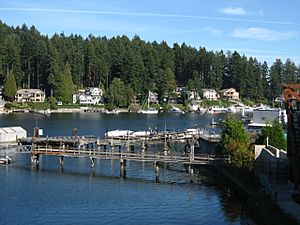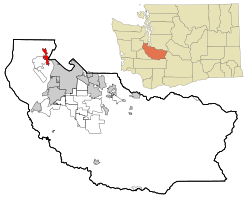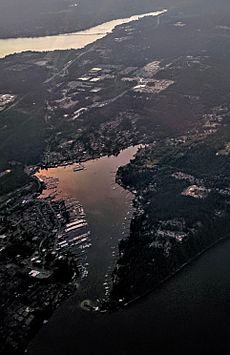Gig Harbor, Washington facts for kids
Quick facts for kids
Gig Harbor, Washington
txʷaalqəɬ
|
|
|---|---|
 |
|
| Nickname(s):
The Maritime City, The Harbor
|
|

Location of Gig Harbor, Washington
|
|
| Country | United States |
| State | Washington |
| County | Pierce |
| Government | |
| • Type | Strong Mayor |
| Area | |
| • Total | 6.12 sq mi (15.85 km2) |
| • Land | 5.90 sq mi (15.29 km2) |
| • Water | 0.22 sq mi (0.56 km2) |
| Elevation | 36 ft (11 m) |
| Population
(2020)
|
|
| • Total | 12,029 |
| • Density | 1,815.83/sq mi (701.05/km2) |
| Time zone | UTC−8 (Pacific (PST)) |
| • Summer (DST) | UTC−7 (PDT) |
| ZIP Codes |
98329, 98332, 98335
|
| Area code(s) | 253 |
| FIPS code | 53-26735 |
| GNIS feature ID | 1512239 |
Gig Harbor (pronounced "gig HAR-bor") is a cool city in Washington State. It's located on a bay that's part of Puget Sound in Pierce County. In 2020, about 12,029 people lived there.
Gig Harbor is known as "the Maritime City" because it has a strong connection to boats and the sea. It's a popular place for tourists to visit. People enjoy its historic waterfront, which has fun shops and restaurants. The city is also close to many state and city parks. You can find Gig Harbor along State Route 16, not far from Interstate 5, right after crossing the Tacoma Narrows Bridge.
Contents
Exploring Gig Harbor's Past
Early Inhabitants: The Puyallup People
For thousands of years, the S'Homamish or Homamish people lived in the Gig Harbor area. They are ancestors of today's Puyallup tribe. They called this place Lushootseed: txʷaalqəɬ, which means "place where game exists." There was a Puyallup village with six houses and a large longhouse near the harbor's entrance. This village was there until the late 1800s. Sadly, settlers tore down the longhouse in 1915, and the S'Homamish people were later moved to the Puyallup Indian Reservation.
How Gig Harbor Got Its Name
In 1840, a big storm hit, and Captain Charles Wilkes needed a safe place for his small boat, called a "captain's gig." He found shelter in this harbor. Later, when Wilkes published his map in 1841, he named the bay Gig Harbor after his boat.
Founding and Early Growth
In 1867, a fisherman named Samuel Jerisich came to Gig Harbor. Many other immigrants from Sweden, Norway, and Croatia also settled there. The town was officially planned out in 1888 by Alfred M. Burnham, who owned a local store. He told people about the great opportunities in Gig Harbor.
Gig Harbor's Main Industries
In the early days, Gig Harbor's economy was all about fishing, building boats, and logging. The town had two main business areas in the 1920s, on opposite sides of the harbor.
Connecting to Tacoma: Bridges and Ferries
Getting between Gig Harbor and Tacoma used to be tricky. People mostly used the "Mosquito fleet," which were steamships that carried passengers across Puget Sound. Driving to Tacoma meant a long 107-mile trip through Olympia.
In 1927, a ferry service started that could carry 80 vehicles. The first Tacoma Narrows Bridge was finished in 1940 to replace the ferry. But it famously collapsed just a few months later! The ferry service came back until the next bridge was built in 1950. A third bridge opened in 2007 to handle more traffic.
Becoming a City
Gig Harbor officially became a town on July 12, 1946. By 1950, it had 803 residents. The new bridge made it easy for people to live in Gig Harbor and work in Tacoma, so the town grew quickly. Gig Harbor became a city in 1981.
In the 1980s and 1990s, more homes and shops were built, pushing the city's edges closer to State Route 16. The downtown area then focused more on tourism. While the historic boat building industry slowed down, its old facilities are still preserved as important landmarks. Today, many commercial fishing boats are based in Gig Harbor. They travel to Alaska every summer to catch salmon.
Skansie Shipyard: A Boat Building Legacy
In 1905, the Skansie brothers were the first in the area to build a fishing boat powered by gasoline. They started by adding small gasoline engines (around 6 to 8 horsepower) to existing boats. These early powerboats didn't use masts or special equipment to hoist nets; all that work was done by hand. The Skansie shipyards built fishing boats from the late 1910s to the early 1950s.
Gig Harbor's Location and Weather
Geography of the City
Gig Harbor covers about 5.96 square miles (15.44 square kilometers). Most of this area is land, with a very small part being water.
Climate and Temperatures
| Weather chart for Gig Harbor | |||||||||||||||||||||||||||||||||||||||||||||||
|---|---|---|---|---|---|---|---|---|---|---|---|---|---|---|---|---|---|---|---|---|---|---|---|---|---|---|---|---|---|---|---|---|---|---|---|---|---|---|---|---|---|---|---|---|---|---|---|
| J | F | M | A | M | J | J | A | S | O | N | D | ||||||||||||||||||||||||||||||||||||
|
5.4
47
35
|
4.4
50
36
|
4.2
55
39
|
2.9
60
42
|
2
66
47
|
1.6
71
52
|
0.9
76
55
|
0.8
77
55
|
1.4
71
51
|
3.4
61
45
|
6.1
52
40
|
5.9
47
35
|
||||||||||||||||||||||||||||||||||||
| temperatures in °F precipitation totals in inches |
|||||||||||||||||||||||||||||||||||||||||||||||
|
Metric conversion
|
|||||||||||||||||||||||||||||||||||||||||||||||
Gig Harbor has a marine west coast climate. This means it has warm, dry summers and cool, wet winters, with some snow now and then. Spring and autumn are in-between seasons. The average temperature in Gig Harbor is about 52 degrees Fahrenheit (11 degrees Celsius).
Who Lives in Gig Harbor?
| Historical population | |||
|---|---|---|---|
| Census | Pop. | %± | |
| 1890 | 321 | — | |
| 1950 | 803 | — | |
| 1960 | 1,094 | 36.2% | |
| 1970 | 1,657 | 51.5% | |
| 1980 | 2,429 | 46.6% | |
| 1990 | 3,236 | 33.2% | |
| 2000 | 6,465 | 99.8% | |
| 2010 | 7,126 | 10.2% | |
| 2020 | 12,029 | 68.8% | |
| U.S. Decennial Census 2020 Census |
|||
Population Details from 2010
In 2010, 7,126 people lived in Gig Harbor. There were 3,291 households, and 1,937 of those were families. Most residents (90.2%) were White. About 2.4% were Asian, and 0.6% were Native American. People of Hispanic or Latino background made up 5.8% of the population.
The average age in the city was 48.1 years old. About 18% of residents were under 18, and 25% were 65 or older. The population was 46% male and 54% female.
Learning and Schools
The Peninsula School District serves Gig Harbor and the surrounding area. It has three high schools:
- Gig Harbor High School
- Peninsula High School
- Henderson Bay Alternative High School
Tacoma Community College also has a campus in Gig Harbor, which opened in 1992.
Famous People from Gig Harbor
Many interesting people have connections to Gig Harbor! Here are a few:
- Marian Call – a singer-songwriter
- Jini Dellaccio – a photographer
- Nevin Harrison – an American sprint canoeist who trained with the Gig Harbor Canoe and Kayak Racing Team
- Scott Hatteberg – a baseball player, whose story was in the movie Moneyball
- Kevin Johnson – the former CEO of Starbucks
- Casey Kasem – a famous actor and radio voiceover artist (he lived in Gig Harbor until he passed away in 2014)
- Josh Lucas – an actor
- Cory Procter – a former NFL football player
- Austin Seferian-Jenkins – an NFL football player
- Paul Skansi – an NFL football player
- Kyle Stanley – a professional golfer
- Dave Krusen – a drummer and member of the Rock Hall of Fame
See also
 In Spanish: Gig Harbor para niños
In Spanish: Gig Harbor para niños




